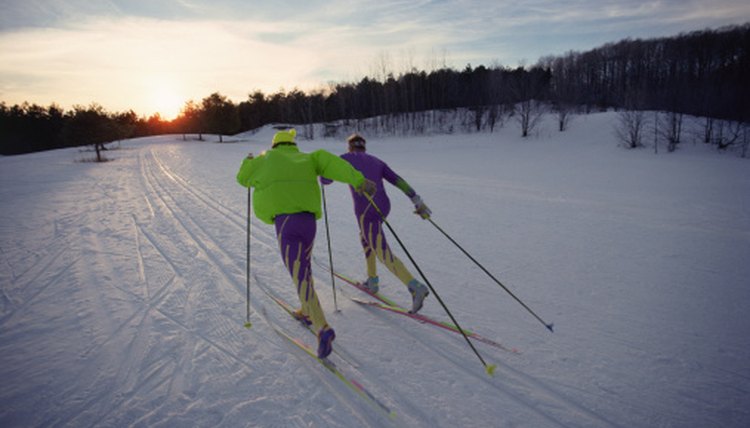What does fact checked mean?
At SportsRec, we strive to deliver objective content that is accurate and up-to-date. Our team periodically reviews articles in order to ensure content quality. The sources cited below consist of evidence from peer-reviewed journals, prominent medical organizations, academic associations, and government data.
- Sports Medicine: Cross-Country Skiing Injuries and Biomechanics; P. Renstrom and R.J. Johnson; Dec. 1989
- Sports Medicine: Cross-Country Skiing Injuries and Biomechanics; P. Renstrom and R.J. Johnson; Dec. 1989
- Medicine and Science in Sports Exercise: Propulsive and Gliding Phases in Four Cross-Country Skiing Techniques; B. Bilodeau, M.R. Boulay, B. Roy; Aug. 1992
- Medicine and Science in Sports Exercise: Propulsive and Gliding Phases in Four Cross-Country Skiing Techniques; B. Bilodeau, M.R. Boulay, B. Roy; Aug. 1992
The information contained on this site is for informational purposes only, and should not be used as a substitute for the advice of a professional health care provider. Please check with the appropriate physician regarding health questions and concerns. Although we strive to deliver accurate and up-to-date information, no guarantee to that effect is made.
Muscles to Strengthen for Cross-Country Skiing

Cross-country skiing gives a full-body workout. Poling works out the upper body muscles, while the skating motion works out your lower body. If you don't want to pull any muscles while cross-country skiing next winter season, you'll want to focus on strengthening your legs, arms, back and chest during the off-season.
Classic Stride Technique
Cross-country skiing with the classic stride technique takes place in the created tracks on the trail. You place your skis in the tracks and slide the skis forward to propel yourself. The main muscles used in the classic stride include those of the thighs and lower leg. Rollerblading or working out on a lateral slide board at the gym are two ways to focus on strengthening your legs before skiing. The upper arm muscles are exercised when you use the poles to propel your body forward, so focus on bicep curls and triceps dips in the off-season to strengthen your arms.
Double Poling Technique
The double poling technique is the most rare of the cross-country skiing techniques and is performed by placing the skis in the tracks, like the classic technique, but using only arm movement with the poles to propel you forward. The main muscles used for this technique include those in your chest, upper back, upper arms and shoulders, plus your abdominals for stability. Focus on core strengthening exercises that also incorporate your arms, like planks or various yoga poses.
Skating Technique
The skating technique does not use the tracks but rather allows the skier to glide across a flattened area of snow, using a motion similar to ice skating. The major muscles used in the skating technique include the gluteal and upper leg muscles, and the upper arm muscles are needed to manipulate the poles. In addition to rollerblading or ice skating, lunges, squats and leg presses can all help strengthen your leg muscles to prepare you for your cross-country adventure.
Strengthening Exercises
Lunges and squats challenge the quadriceps, hamstrings and calf muscles both in strength and stability. To further challenge your muscles, you can perform these exercises while holding hand weights. Seated leg curls work the hamstrings, while standing leg curls work both the hamstrings and the gluteus maximus. Biceps curls and triceps kickbacks using dumbbells are two of the most effective strengthening exercises for the arms. ACE-certified personal trainer Megan Tyner suggests working out on an elliptical machine to get used to the motion of cross-country skiing. She says one advantage to using an elliptical is that you can adjust the incline and resistance of some machines to make your workout easier or more rigorous.
References
- Spine Health: Elliptical Trainer; Megan Tyner; May 2007
- Sports Medicine: Cross-Country Skiing Injuries and Biomechanics; P. Renstrom and R.J. Johnson; Dec. 1989
- Medicine and Science in Sports Exercise: Propulsive and Gliding Phases in Four Cross-Country Skiing Techniques; B. Bilodeau, M.R. Boulay, B. Roy; Aug. 1992
Writer Bio
Based in Dayton, Ohio, Sari Hardyal has been writing fitness, sports, entertainment and health-related articles for more than five years. Hardyal holds a Bachelor of Science in mass communication from Miami University and is pursuing her master's degree in occupational therapy and her doctorate in physical therapy. She is a certified personal trainer with the National Federation of Professional Trainers.
